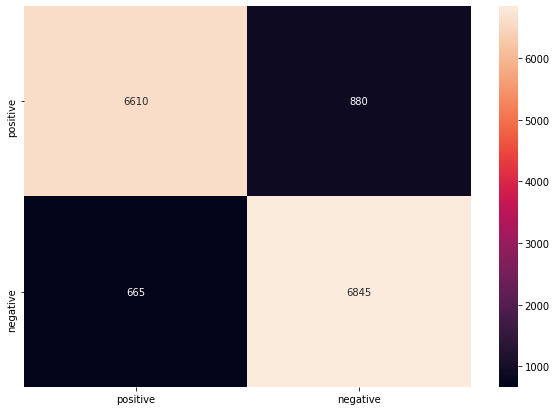Sentiment Analysis with Traditional Machine Learning#
This note is based on Text Analytics with Python Ch9 Sentiment Analysis by Dipanjan Sarkar
Logistic Regression
Support Vector Machine (SVM)
Import necessary depencencies#
import pandas as pd
import numpy as np
#import text_normalizer as tn
#import model_evaluation_utils as meu
import nltk
np.set_printoptions(precision=2, linewidth=80)
Load and normalize data#
%%time
dataset = pd.read_csv('../data/movie_reviews.csv')
CPU times: user 358 ms, sys: 52.9 ms, total: 411 ms
Wall time: 2.16 s
# take a peek at the data
print(dataset.head())
reviews = np.array(dataset['review'])
sentiments = np.array(dataset['sentiment'])
review sentiment
0 One of the other reviewers has mentioned that ... positive
1 A wonderful little production. <br /><br />The... positive
2 I thought this was a wonderful way to spend ti... positive
3 Basically there's a family where a little boy ... negative
4 Petter Mattei's "Love in the Time of Money" is... positive
type(reviews)
reviews.shape
sentiments.shape
(50000,)
# build train and test datasets
train_reviews = reviews[:35000]
train_sentiments = sentiments[:35000]
test_reviews = reviews[35000:]
test_sentiments = sentiments[35000:]
reviews[0][:100]
sentiments[0:10]
train_reviews[0][:100]
test_reviews[0][:100]
test_sentiments[0]
'negative'
Normalizing the Corpus#
# normalize datasets
# stop_words = nltk.corpus.stopwords.words('english')
# stop_words.remove('no')
# stop_words.remove('but')
# stop_words.remove('not')
# norm_train_reviews = tn.normalize_corpus(train_reviews, stopwords=stop_words)
# norm_test_reviews = tn.normalize_corpus(test_reviews, stopwords=stop_words)
norm_train_reviews = train_reviews.tolist()
norm_test_reviews = test_reviews.tolist()
Traditional Supervised Machine Learning Models#
Logistic
SVM
Feature Engineering#
%%time
from sklearn.feature_extraction.text import CountVectorizer, TfidfVectorizer
# build BOW features on train reviews
cv = CountVectorizer(binary=False, min_df=10, max_df=0.7, ngram_range=(1,3))
cv_train_features = cv.fit_transform(norm_train_reviews)
# build TFIDF features on train reviews
tv = TfidfVectorizer(use_idf=True, min_df=10, max_df=0.7, ngram_range=(1,3),
sublinear_tf=True)
tv_train_features = tv.fit_transform(norm_train_reviews)
CPU times: user 59.3 s, sys: 1.96 s, total: 1min 1s
Wall time: 1min 2s
# transform test reviews into features
cv_test_features = cv.transform(norm_test_reviews)
tv_test_features = tv.transform(norm_test_reviews)
print('BOW model:> Train features shape:', cv_train_features.shape, ' Test features shape:', cv_test_features.shape)
print('TFIDF model:> Train features shape:', tv_train_features.shape, ' Test features shape:', tv_test_features.shape)
BOW model:> Train features shape: (35000, 161562) Test features shape: (15000, 161562)
TFIDF model:> Train features shape: (35000, 161562) Test features shape: (15000, 161562)
Model Training, Prediction and Performance Evaluation#
from sklearn.linear_model import SGDClassifier, LogisticRegression
lr = LogisticRegression(penalty='l2', max_iter=200, C=1)
svm = SGDClassifier(loss='hinge', max_iter=200)
Note
pd.MultiIndex() has been updated in Sarker’s code. The argument codes= is new.
# functions from Text Analytics with Python book
def get_metrics(true_labels, predicted_labels):
print('Accuracy:', np.round(
metrics.accuracy_score(true_labels,
predicted_labels),
4))
print('Precision:', np.round(
metrics.precision_score(true_labels,
predicted_labels,
average='weighted'),
4))
print('Recall:', np.round(
metrics.recall_score(true_labels,
predicted_labels,
average='weighted'),
4))
print('F1 Score:', np.round(
metrics.f1_score(true_labels,
predicted_labels,
average='weighted'),
4))
def display_confusion_matrix(true_labels, predicted_labels, classes=[1,0]):
total_classes = len(classes)
level_labels = [total_classes*[0], list(range(total_classes))]
cm = metrics.confusion_matrix(y_true=true_labels, y_pred=predicted_labels,
labels=classes)
cm_frame = pd.DataFrame(data=cm,
columns=pd.MultiIndex(levels=[['Predicted:'], classes],
codes=level_labels),
index=pd.MultiIndex(levels=[['Actual:'], classes],
codes=level_labels))
print(cm_frame)
def display_classification_report(true_labels, predicted_labels, classes=[1,0]):
report = metrics.classification_report(y_true=true_labels,
y_pred=predicted_labels,
labels=classes)
print(report)
def display_model_performance_metrics(true_labels, predicted_labels, classes=[1,0]):
print('Model Performance metrics:')
print('-'*30)
get_metrics(true_labels=true_labels, predicted_labels=predicted_labels)
print('\nModel Classification report:')
print('-'*30)
display_classification_report(true_labels=true_labels, predicted_labels=predicted_labels,
classes=classes)
print('\nPrediction Confusion Matrix:')
print('-'*30)
display_confusion_matrix(true_labels=true_labels, predicted_labels=predicted_labels,
classes=classes)
from sklearn import metrics
%%time
# build model
lr.fit(cv_train_features, train_sentiments)
# predict using model
lr_bow_predictions = lr.predict(cv_test_features)
svm.fit(cv_train_features, train_sentiments)
svm_bow_predictions = svm.predict(cv_test_features)
# Logistic Regression model on BOW features
# lr_bow_predictions = meu.train_predict_model(classifier=lr,
# train_features=cv_train_features, train_labels=train_sentiments,
# test_features=cv_test_features, test_labels=test_sentiments)
/Users/Alvin/opt/anaconda3/envs/ckiptagger/lib/python3.6/site-packages/sklearn/linear_model/_logistic.py:764: ConvergenceWarning: lbfgs failed to converge (status=1):
STOP: TOTAL NO. of ITERATIONS REACHED LIMIT.
Increase the number of iterations (max_iter) or scale the data as shown in:
https://scikit-learn.org/stable/modules/preprocessing.html
Please also refer to the documentation for alternative solver options:
https://scikit-learn.org/stable/modules/linear_model.html#logistic-regression
extra_warning_msg=_LOGISTIC_SOLVER_CONVERGENCE_MSG)
CPU times: user 28.7 s, sys: 41.3 s, total: 1min 9s
Wall time: 19.8 s
display_model_performance_metrics(true_labels=test_sentiments, predicted_labels=lr_bow_predictions,
classes=['positive','negative'])
Model Performance metrics:
------------------------------
Accuracy: 0.9051
Precision: 0.9052
Recall: 0.9051
F1 Score: 0.9051
Model Classification report:
------------------------------
precision recall f1-score support
positive 0.90 0.91 0.91 7510
negative 0.91 0.90 0.90 7490
accuracy 0.91 15000
macro avg 0.91 0.91 0.91 15000
weighted avg 0.91 0.91 0.91 15000
Prediction Confusion Matrix:
------------------------------
Predicted:
positive negative
Actual: positive 6831 679
negative 744 6746
display_model_performance_metrics(true_labels=test_sentiments, predicted_labels=svm_bow_predictions,
classes=['positive','negative'])
Model Performance metrics:
------------------------------
Accuracy: 0.897
Precision: 0.8973
Recall: 0.897
F1 Score: 0.897
Model Classification report:
------------------------------
precision recall f1-score support
positive 0.89 0.91 0.90 7510
negative 0.91 0.88 0.90 7490
accuracy 0.90 15000
macro avg 0.90 0.90 0.90 15000
weighted avg 0.90 0.90 0.90 15000
Prediction Confusion Matrix:
------------------------------
Predicted:
positive negative
Actual: positive 6845 665
negative 880 6610
from sklearn.metrics import confusion_matrix
lr_bow_cm = confusion_matrix(test_sentiments, lr_bow_predictions)
svm_bow_cm = confusion_matrix(test_sentiments, svm_bow_predictions)
# lr_bow_cm.shape[1]
print(lr_bow_cm)
print(svm_bow_cm)
[[6746 744]
[ 679 6831]]
[[6610 880]
[ 665 6845]]
## MultiIndex DataFrame demo
import seaborn as sn
import pandas as pd
import matplotlib.pyplot as plt
# convert array to data frame
classes = ['positive','negative']
lr_bow_df_cm = pd.DataFrame(lr_bow_cm,
index = pd.MultiIndex(levels=[['Actual'],classes],
codes=[[0,0],[0,1]]),
columns = pd.MultiIndex(levels=[['Predicted'],classes],
codes=[[0,0],[0,1]]))
lr_bow_df_cm
| Predicted | |||
|---|---|---|---|
| positive | negative | ||
| Actual | positive | 6746 | 744 |
| negative | 679 | 6831 | |
# pd.MultiIndex(levels=[['Predicted:'],['positive', 'negative']],
# codes=[[0,0],[1,0]])
# classes=['Positive','Negative']
# total_classes = len(classes)
# level_labels = [total_classes*[0], list(range(total_classes))]
# print(total_classes)
# print(level_labels)
svm_bow_df_cm = pd.DataFrame(svm_bow_cm, index = ['positive', 'negative'],
columns = ['positive', 'negative'])
svm_bow_df_cm
| positive | negative | |
|---|---|---|
| positive | 6610 | 880 |
| negative | 665 | 6845 |
plt.figure(figsize = (10,7))
sn.heatmap(lr_bow_df_cm, annot=True, fmt='.5g')
<AxesSubplot:xlabel='None-None', ylabel='None-None'>

plt.figure(figsize = (10,7))
sn.heatmap(svm_bow_df_cm, annot=True, fmt='.5g')
<AxesSubplot:>

display_model_performance_metrics(true_labels=test_sentiments, predicted_labels=lr_bow_predictions,classes=['positive', 'negative'])
Model Performance metrics:
------------------------------
Accuracy: 0.9051
Precision: 0.9052
Recall: 0.9051
F1 Score: 0.9051
Model Classification report:
------------------------------
precision recall f1-score support
positive 0.90 0.91 0.91 7510
negative 0.91 0.90 0.90 7490
accuracy 0.91 15000
macro avg 0.91 0.91 0.91 15000
weighted avg 0.91 0.91 0.91 15000
Prediction Confusion Matrix:
------------------------------
Predicted:
positive negative
Actual: positive 6831 679
negative 744 6746
display_model_performance_metrics(true_labels=test_sentiments, predicted_labels=svm_bow_predictions,classes=['positive', 'negative'])
Model Performance metrics:
------------------------------
Accuracy: 0.897
Precision: 0.8973
Recall: 0.897
F1 Score: 0.897
Model Classification report:
------------------------------
precision recall f1-score support
positive 0.89 0.91 0.90 7510
negative 0.91 0.88 0.90 7490
accuracy 0.90 15000
macro avg 0.90 0.90 0.90 15000
weighted avg 0.90 0.90 0.90 15000
Prediction Confusion Matrix:
------------------------------
Predicted:
positive negative
Actual: positive 6845 665
negative 880 6610
# Logistic Regression model on TF-IDF features
# lr_tfidf_predictions = meu.train_predict_model(classifier=lr,
# train_features=tv_train_features, train_labels=train_sentiments,
# test_features=tv_test_features, test_labels=test_sentiments)
#meu.display_model_performance_metrics(true_labels=test_sentiments, predicted_labels=lr_tfidf_predictions,
# classes=['positive', 'negative'])
# svm_bow_predictions = meu.train_predict_model(classifier=svm,
# train_features=cv_train_features, train_labels=train_sentiments,
# test_features=cv_test_features, test_labels=test_sentiments)
# meu.display_model_performance_metrics(true_labels=test_sentiments, predicted_labels=svm_bow_predictions,
# classes=['positive', 'negative'])
# svm_tfidf_predictions = meu.train_predict_model(classifier=svm,
# train_features=tv_train_features, train_labels=train_sentiments,
# test_features=tv_test_features, test_labels=test_sentiments)
# # meu.display_model_performance_metrics(true_labels=test_sentiments, predicted_labels=svm_tfidf_predictions,
# classes=['positive', 'negative'])
Explaining Model (LIME)#
from lime import lime_text
from sklearn.pipeline import make_pipeline
c = make_pipeline(cv, lr)
print(c.predict_proba([norm_test_reviews[0]]))
[[0.98 0.02]]
from lime.lime_text import LimeTextExplainer
explainer = LimeTextExplainer(class_names=['positive','negative'])
idx = 200
exp = explainer.explain_instance(norm_test_reviews[idx], c.predict_proba, num_features=6)
print('Document id: %d' % idx)
print('Probability(negative) =', c.predict_proba([norm_test_reviews[idx]])[0,1])
print('True class: %s' % test_sentiments[idx])
/Users/Alvin/opt/anaconda3/envs/ckiptagger/lib/python3.6/site-packages/lime/lime_text.py:114: FutureWarning: split() requires a non-empty pattern match.
self.as_list = [s for s in splitter.split(self.raw) if s]
Document id: 200
Probability(negative) = 0.9463219141695278
True class: negative
exp.as_list()
[('excellent', 0.162595418803554),
('well', 0.12915838814832345),
('pretty', -0.12389044715181954),
('just', -0.12389037509864227),
('is', 0.11544701679553886),
('very', 0.11165341872148259)]
print('Original prediction:', lr.predict_proba(cv_test_features[idx])[0,1])
tmp = cv_test_features[idx].copy()
tmp[0,cv.vocabulary_['excellent']] = 0
tmp[0,cv.vocabulary_['see']] = 0
print('Prediction removing some features:', lr.predict_proba(tmp)[0,1])
print('Difference:', lr.predict_proba(tmp)[0,1] - lr.predict_proba(cv_test_features[idx])[0,1])
Original prediction: 0.9463219141695278
Prediction removing some features: 0.7695892761501267
Difference: -0.1767326380194011
fig = exp.as_pyplot_figure()

exp.show_in_notebook(text=True)
SVM#
from sklearn.calibration import CalibratedClassifierCV
calibrator = CalibratedClassifierCV(svm, cv='prefit')
svm2=calibrator.fit(cv_train_features, train_sentiments)
c2 = make_pipeline(cv, svm2)
print(c2.predict_proba([norm_test_reviews[0]]))
[[0.9 0.1]]
idx = 200
exp = explainer.explain_instance(norm_test_reviews[idx], c2.predict_proba, num_features=6)
print('Document id: %d' % idx)
print('Probability(negative) =', c2.predict_proba([norm_test_reviews[idx]])[0,1])
print('True class: %s' % test_sentiments[idx])
/Users/Alvin/opt/anaconda3/envs/ckiptagger/lib/python3.6/site-packages/lime/lime_text.py:114: FutureWarning: split() requires a non-empty pattern match.
self.as_list = [s for s in splitter.split(self.raw) if s]
Document id: 200
Probability(negative) = 0.8529415009424632
True class: negative
exp.as_list()
[('very', 0.1312736594001693),
('excellent', 0.12269801222754814),
('well', 0.11944614464334685),
('fine', 0.10496804950240192),
('just', -0.10181362382996519),
('pretty', -0.08928942634771304)]
print('Original prediction:', svm2.predict_proba(cv_test_features[idx])[0,1])
tmp = cv_test_features[idx].copy()
tmp[0,cv.vocabulary_['excellent']] = 0
tmp[0,cv.vocabulary_['well']] = 0
print('Prediction removing some features:', svm2.predict_proba(tmp)[0,1])
print('Difference:', svm2.predict_proba(tmp)[0,1] - lr.predict_proba(cv_test_features[idx])[0,1])
Original prediction: 0.8529415009424632
Prediction removing some features: 0.7351422555589386
Difference: -0.21117965861058918
fig = exp.as_pyplot_figure()

exp.show_in_notebook(text=True)

